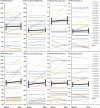A 1-week diet break improves muscle endurance during an intermittent dieting regime in adult athletes: A pre-specified secondary analysis of the ICECAP trial
- PMID: 33630880
- PMCID: PMC7906362
- DOI: 10.1371/journal.pone.0247292
A 1-week diet break improves muscle endurance during an intermittent dieting regime in adult athletes: A pre-specified secondary analysis of the ICECAP trial
Abstract
Athletes undergoing energy restriction for weight/fat reduction sometimes apply 'diet breaks' involving increased energy intake, but there is little empirical evidence of effects on outcomes. Twenty-six resistance-trained athletes (11/26 or 42% female) who had completed 12 weeks of intermittent energy restriction participated in this study. Participants had a mean (SD) age of 29.3 (6.4) years, a weight of 72.7 (15.9) kg, and a body fat percentage of 21.3 (7.5) %. During the 1-week diet break, energy intake was increased (by means of increased carbohydrate intake) to predicted weight maintenance requirements. While the 1-week diet break had no significant effect on fat mass, it led to small but significant increases in mean body weight (0.6 kg, P<0.001), fat-free mass (0.7 kg, P<0.001) and in resting energy expenditure, from a mean (and 95% confidence interval) of 7000 (6420 to 7580) kJ/day to 7200 (6620 to 7780) kJ/day (P = 0.026). Overall, muscle endurance in the legs (but not arms) improved after the diet break, including significant increases in the work completed by the quadriceps and hamstrings in a maximum-effort 25-repetition set, with values increasing from 2530 (2170 to 2890) J to 2660 (2310 to 3010) J (P = 0.018) and from 1280 (1130 to 1430) J to 1380 (1220 to 1540) J (P = 0.018) following the diet break, respectively. However, muscle strength did not change. Participants reported significantly lower sensations of hunger (P = 0.017), prospective consumption (P = 0.020) and irritability (P = 0.041) after the diet break, and significantly higher sensations of fullness (P = 0.002), satisfaction (P = 0.002), and alertness (P = 0.003). In summary, a 1-week diet break improved muscle endurance in the legs and increased mental alertness, and reduced appetite and irritability. With this considered, it may be wise for athletes to coordinate diet breaks with training sessions that require muscle endurance of the legs and/or mental focus, as well as in the latter parts of a weight loss phase when increases in appetite might threaten dietary adherence. Trial registration: Australian New Zealand Clinical Trials Registry Reference Number: ACTRN12618000638235 anzctr.org.au.
Conflict of interest statement
AS reported owning 50% of the shares in Zuman International, which receives royalties for books she has written and payments for presentations at industry conferences; receiving presentation fees and travel reimbursements from Eli Lilly and Co, the Pharmacy Guild of Australia, Novo Nordisk, the Dietitians Association of Australia, Shoalhaven Family Medical Centres, the Pharmaceutical Society of Australia, and Metagenics; and serving on the NestleÌ Health Science Optifast VLCD advisory board from 2016 to 2018. JK is employed by Weightology LLC. These affiliations do not alter our adherence to PLOS ONE policies on sharing data and materials.
Figures




Similar articles
-
Continuous versus Intermittent Dieting for Fat Loss and Fat-Free Mass Retention in Resistance-trained Adults: The ICECAP Trial.Med Sci Sports Exerc. 2021 Aug 1;53(8):1685-1698. doi: 10.1249/MSS.0000000000002636. Med Sci Sports Exerc. 2021. PMID: 33587549 Clinical Trial.
-
Compensatory mechanisms activated with intermittent energy restriction: A randomized control trial.Clin Nutr. 2018 Jun;37(3):815-823. doi: 10.1016/j.clnu.2017.04.002. Epub 2017 Apr 7. Clin Nutr. 2018. PMID: 28446382 Clinical Trial.
-
Structured, aerobic exercise reduces fat mass and is partially compensated through energy intake but not energy expenditure in women.Physiol Behav. 2019 Feb 1;199:56-65. doi: 10.1016/j.physbeh.2018.11.005. Epub 2018 Nov 7. Physiol Behav. 2019. PMID: 30414399
-
Effects of bodyweight reduction on sports performance.Sports Med. 1994 Oct;18(4):249-67. doi: 10.2165/00007256-199418040-00004. Sports Med. 1994. PMID: 7817064 Review.
-
Hunger disease.Clin Nutr. 2000 Dec;19(6):379-86. doi: 10.1054/clnu.2000.0157. Clin Nutr. 2000. PMID: 11104587 Review.
Cited by
-
Peak Week Carbohydrate Manipulation Practices in Physique Athletes: A Narrative Review.Sports Med Open. 2024 Jan 13;10(1):8. doi: 10.1186/s40798-024-00674-z. Sports Med Open. 2024. PMID: 38218750 Free PMC article. Review.
References
-
- Langan-Evans C, Close GL, Morton JP. Making weight in combat sports. Strength Cond J. 2011;33(25–39).
Publication types
MeSH terms
Associated data
LinkOut - more resources
Full Text Sources
Other Literature Sources
Medical

